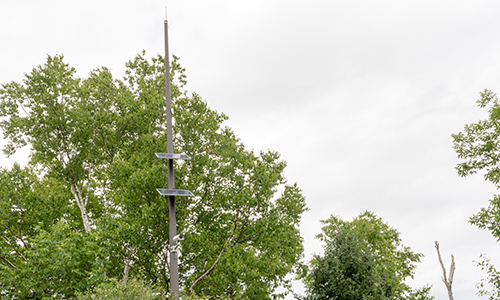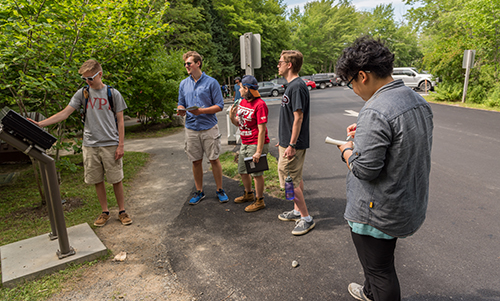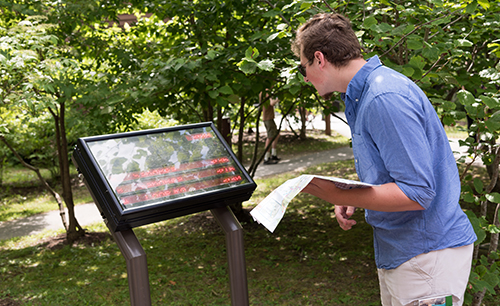Intelligent Transportation Project

WPI Bar Harbor Project Center: Reducing Traffic in Acadia National Park
Student project seeks to bring intelligent transportation system to popular tourist attraction
Acadia National Park, located on Mount Desert Island in Maine, is the eighth most popular national park in America. It’s also the 13th smallest national park, meaning each summer it quickly fills up with tourists as well as their cars.
“In recent years the park has had over three million visitors annually,” says WPI robotics engineering major Daniel Wivagg. “During peak season, parking lots are overflowing and there is not enough room to drive in many parts of the park.”
- Daniel Wivagg, Junior
Wivagg and four other WPI students recently spent seven weeks at WPI’s Bar Harbor Project Center tackling the problem of traffic overcrowding and bottlenecks in Acadia as part of their Interactive Qualifying Project (IQP), a team-based project that requires students to delve into problems that matter to real people. The team also included chemical engineering major Angela Calvi, aerospace engineering major Colin Maki, aerospace engineering major Jackson Peters, and mechanical engineering major Mingqi Shuai.

Outdated equipment from the intelligent transportation system initiative from 15 years ago
The project was sponsored by the National Park Service (NPS) and sought to investigate and update an initiative begun by the NPS 15 years ago that has since stalled: the implementation of an intelligent transportation system (ITS), a system of interconnected applications that collect, analyze, and disseminate information about traffic in real time.
The initial ITS featured nine components, including sensors at park entrances to count visitor numbers, cameras to monitor parking lots, signs to display available numbers of parking spots, and a tourist shuttle, the last of which is the only component still in use today.
Charlie Jacobi, a park ranger with the NPS, explains that the system faced multiple obstacles.
“The previous ITS failed because of poor cell phone communications as well as the inability of software to be able to compile traffic data and report out meaningful information on visitors,” says Jacobi. “And park staff simply did not have the time to look into these issues in detail.”
He adds, “The WPI students bring the technological know-how. It was a benefit for the park to have the students investigate changes over the last five to ten years in communications and software so that we can see whether any kind of system could be revived for the park.”
- Charlie Jacobi, Project Sponsor
The students approached the project in several phases, including fieldwork and intense research.

WPI student team conducting field work at Acadia National Park
Nature Center
“We went out to observe traffic flow in different areas once or twice a week, but we really spent the majority of our time investigating components for the ITS,” says Wivagg.
In order to evaluate the success of the previous ITS, the students also spoke with local stakeholders and combed through government reports on the initial effort in Acadia. They determined that the tourist shuttle was still working effectively and that other components could be re-introduced using updated technologies.
One component the students paid particular attention to was a new parking lot monitoring system that could keep track of the number of available parking spots in individual lots.
“We evaluated a few possible components based on technical considerations and price,” Calvi explains. “One of them, a camera monitoring system, was part of the old ITS but was not maintained and had become outdated. We also determined that another component, an induction loop system using sensors embedded in the ground, was costly and difficult to implement.”
She continues, “We ultimately recommended a newer and more cost effective system that uses sensors called magnetometers that can be mounted on poles to count passing cars.”
- Angela Calvi, Junior
The team also investigated methods of disseminating information about park traffic to visitors. They found that local hotels already promoted the tourist shuttle but failed to promote its companion mobile application, which provides schedule information in real-time. As a solution, they not only proposed additional promotional activities but also designed a mock-up of a more extensive app and website to help visitors plan their trips by compiling and sharing traffic data.

Student team member Jackson Peters investigates the electronic scheduling bus sign at the Nature Center
Finally, the students recommended that the park install dynamic signs to display parking lot availability on site and invest in robust software that could more easily manage the data flow between system components.
Going forward, the team proposed that the NPS conduct a trial implementation of their recommended ITS in one high-traffic area before rolling it out park-wide.
Jacobi hopes to do just that, possibly with the assistance of another WPI team, in the future.
“There is a definite possibility of running a low-cost experiment transmitting data about at least one hotspot in the park in a timely manner that we can disseminate to visitors,” he says. “We will be discussing next steps in the fall and explaining how WPI can help.”
In the meantime, Jacobi is following up on individual findings from the report.
“I was intrigued enough by the magnetometer recommendation to ask our own traffic engineers in Denver about them,” says Jacobi. “I also liked the work done with hotels to see how much the shuttle and apps are being promoted. That's helpful information.”
- Charlie Jacobi, Project Sponsor
The students are also hopeful that their findings will have a real impact in the future, in Acadia and in other places.
“The park does not have the time or resources to pursue this type of work on their own, so I think we made a real difference by being there,” says Wivagg. “Maybe I can come back and visit in a few years and see how much our project has helped change the visitor experience.”
Calvi adds, “Intelligent transportation systems have been successfully implemented in some cities, but they have not been widely used in natural settings like Acadia. If the system works here it absolutely could be implemented in other parks and natural spaces.”